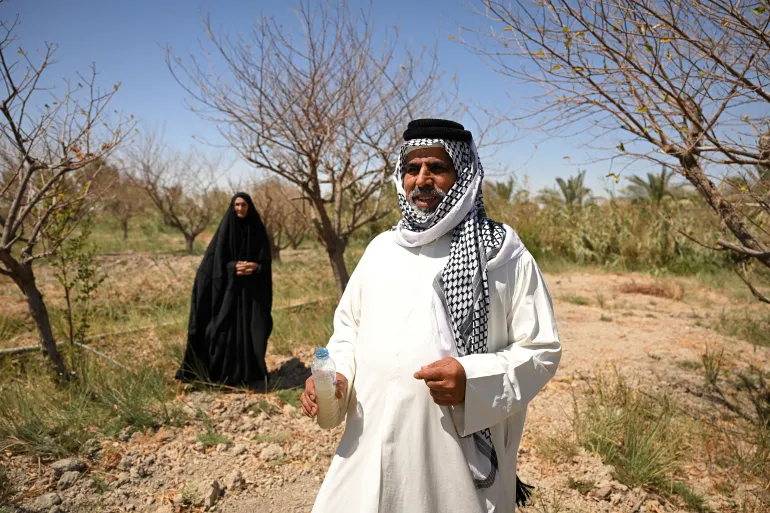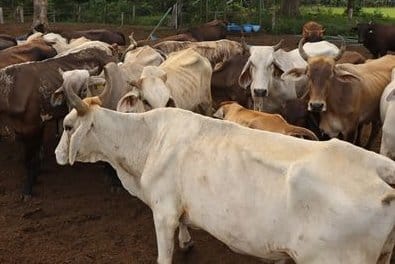Water salinity hurting farmers, livestock in Iraq | Water News
Iraqi farmer Umm Ali has watched her poultry die as salinity levels in the country’s south have reached record highs, rendering already scarce water unfit for human consumption and killing livestock.
“We used to drink, wash and cook with water from the river, but now it’s hurting us,” said Umm Ali, 40, who lives in the once watery Al-Mashab marshes of southern Iraq’s Basra province.
This season alone, she said, brackish water has killed dozens of her ducks and 15 chickens.
“I cried and grieved, I felt as if all my hard work had been wasted,” said the widowed mother of three.
Iraq, a country heavily affected by climate change, has been ravaged for years by drought and low rainfall.
Declining freshwater flows have increased salt and pollution levels, particularly in the south, where the Tigris and Euphrates rivers converge before spilling into the Gulf.
“We haven’t seen such high levels of salinity in 89 years,” Iraq’s Ministry of Water Resources spokesman, Khaled Shamal, said.
Last month, salinity levels recorded in the central Basra province soared to almost 29,000 parts per million compared with 2,600ppm last year, according to a Water Ministry report.
Freshwater should contain less than 1,000ppm of dissolved salts, while ocean water salinity levels are about 35,000ppm, according to the United States Geological Survey.

The Tigris and the Euphrates converge at Basra’s Shatt al-Arab waterway “laden with pollutants accumulated along their course”, said Hasan al-Khateeb, an expert from Iraq’s University of Kufa.
In recent weeks, the Euphrates has seen its lowest water levels in decades, and Iraq’s artificial lake reserves are at their lowest in recent history.
Khateeb warned that the Shatt al-Arab’s water levels had plummeted and it was failing to hold back the seawater from the Gulf.
Farmer Zulaykha Hashem, 60, said the water in the area had become very brackish this year, adding that she must wait for the situation to improve to irrigate her crop of pomegranate trees, figs and berries.
According to the United Nations, almost a quarter of women in Basra and nearby provinces work in agriculture.
“We cannot even leave. Where would we go?” Hashem said, in a country where farmers facing drought and rising salinity often find themselves trapped in a cycle of water crisis.
The UN’s International Organization for Migration, which documents climate-induced displacement in Iraq, has warned that increased water salinity is destroying palm groves, citrus trees and other crops.
As of October last year, some 170,000 people had been displaced in central and southern Iraq due to climate-related factors, according to the agency.
Water scarcity pushed Maryam Salman, who is in her 30s, to leave nearby Missan province for Basra several years ago, hoping her buffalo could enjoy the Shatt al-Arab.

Rising salinity is not the only problem now, said Salman, a mother of three children.
“Water is not available … neither summer nor winter,” she said.
The Tigris and the Euphrates originate in Turkiye, and Iraqi authorities have repeatedly blamed dams across the border for significantly reducing their flows.
Iraq, a country with inefficient water management systems after decades of war and neglect, receives less than 35 percent of its allocated share of water from the two rivers, according to authorities.
Khateeb from the University of Kufa said, in addition to claiming its share of the rivers, Iraq must pursue desalination projects in the Shatt al-Arab.
In July, the government announced a desalination project in Basra with a capacity of 1 million cubic metres per day.
Local residents said the brackish water is also impacting fish stocks.
Hamdiyah Mehdi said her husband, who is a fisherman, returns home empty-handed more frequently.
She blamed the Shatt al-Arab’s “murky and salty water” for his short temper after long days without a catch, and for her children’s persistent rash.
“It has been tough,” said Mehdi, 52, noting the emotional toll on the family as well as on their health and livelihood.
“We take our frustrations out on each other.”

